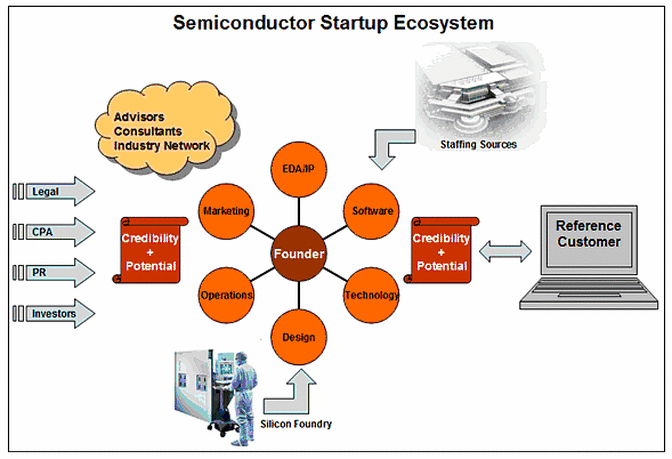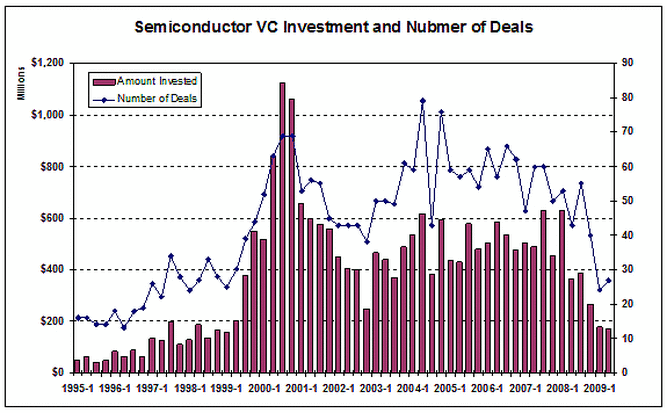 Source: InsideChips
Source: InsideChips The lubricant which keeps the machinery of innovation moving smoothly is venture funding, and there is less being doled out to aspiring start-ups today. In a nutshell, venture funding was so plentiful for entrepreneurs during the years leading up to the dotcom bust in 2001 that many weak business deals were financed and venture capital firms with lean track records were founded. After the shock of the stock market crash in tech stocks (semiconductor valuations in public equities declined 80 percent), the VC landscape changed drastically. A good number of the new VC players dissolved their operations or became "zombies" left with lackluster portfolios, unable to raise new funds and not making investments. VCs which rode out the storm were left in turmoil as a severe liquidity drought set in. When a start-up is unable to convert its private stock into cash, projected returns on VC investments evaporate.
Venture investing is a niche, high-risk/high-reward asset class; and if returns fall below what could be garnered in safer investments, such as the S&P 500 stocks, VCs become very concerned -- especially when every sector of their portfolio gets hit with few exits in sight. Even in better times, Sarbanes-Oxley has made it difficult for small market capitalization firms to do an initial public offering (IPO). When the second quarter of 2008 concluded without a single venture-backed IPO for the first time in 30 years, the National Venture Capital Association (NVCA) warned of a crisis settling over the VC industry.
VCs also faced issues with their limited partners (LPs) -- their investors. LPs asked VCs to reduce the number of capital calls since their debt-to-equity ratios were causing concern. Many VCs honored these requests and reduced their funding plans in start-ups accordingly. In a drive for more transparency, some LPs asked to have their VC partners comply with a mark-to-market accounting rule, a very time-consuming process. Thus, VCs were left with less time to review new deals. Because of these issues, many of the recent investment rounds were "inside rounds" where VCs fund their own portfolio at lower valuations. Investors were faced with the reality of owning their portfolio ventures longer or exit at reduced values in an acquisition. A recent Fenwick & West survey concluded that in the second quarter of 2009 down rounds exceeded up rounds 46 percent to 32 percent, with the remainder flat.
The liquidity crunch in the VC world has brought consequences for semiconductor start-ups. Figure 2 shows total VC investment in the semiconductor industry on a quarterly basis since 1995. VC investment in the semiconductor industry has shrunk to its lowest level since 2000 when it reached $1 billion. At $170 million, the amount received by start-ups in Q2 2009 is only about 15 percent of the dollars garnered in Q3 2000.
 Source: NVCA, PWC
Source: NVCA, PWC Semiconductor start-ups are being squeezed by sharply higher costs to develop innovative chips and dramatically lowered valuations. A novel semiconductor technology that would have required two to three years and $10 million to $25 million in start-up funding to get to proof of concept a few years ago, now requires six to seven years and something closer to $70 million. For those investments, VCs want their acquisitions to be valued at about $400 million to make the numbers work. The median value of semiconductor acquisitions has dropped significantly since 2000. Today's semiconductor acquisition is typically valued in the $50 to $100 million range.
Nevertheless, there is a continuing stream of semiconductor start-up formation, even in this difficult economic environment cycle. Semiconductor start-ups are the creative engines which drive the electronics industry because they develop state-of-the-art ICs for next-generation products and set the pace for semiconductor innovation. Big chipmakers, such as AMD, Texas Instruments, National Semiconductor, Intel, Qualcomm, Broadcom and others, have traditionally relied on innovative ventures for bridging their in-house technologies or as sources of innovation not developed in-house.
The most successful semiconductor companies which will have the biggest potential impact in the marketplace are those that can conceptualize, design and market systems-on-chip (SOCs) which address high-volume applications and develop those chips with software intelligence on-board. This may require international development teams in the U.S. and in other high-tech development centers. For example, software development and even IC design has been migrating to such regions as India, China and Israel.
Time-to-market windows for launching consumer products are short, and original equipment manufacturers (OEMs) are looking for chip companies which can provide an entire ecosystem to the user (i.e., the chip, software, development system and reference designs).
Apple has been a winning example of owning the ecosystem. While their traditional strength was mechanical design, software innovation and hardware based on proprietary chips from outside suppliers, the company's recent strategy shifted to designing their own processors with the acquisition of P.A. Semiconductor in 2008.
In other words, companies which only focus on building faster and cheaper netbooks, for example, will not have a sustainable advantage in the marketplace. The winning companies will build "user-friendly" netbooks which have compelling product features that meet the consumer's lifestyle needs. That's where software can differentiate the hardware to meet these needs. As multicore chips and programmable devices become more mainstream in the marketplace, the distinctions between software and hardware will blur.
The VC landscape has changed dramatically from a decade ago, when a cool idea and a few key founders were all that was required for a start-up to receive funding. The current investment climate is difficult, and entrepreneurs must take additional action to ride out the storm. The stark reality that founders are facing is one that requires them to revise their attitudes and mindsets about their operations and the valuations of their companies -- not an easy proposition given that they were witnesses to the "big money" glory days of the boom only nine years ago. Guerrilla marketing, creative partnering, outside-the-box thinking, bootstrapping, outsourcing and seeking strategic investors should all be part of the mix to survive and prosper.
The bottom line is this -- be ready to accept tougher terms. Liquidation preferences, anti-dilution protection, VCs demanding bigger percentages of companies, bridge discounts/covenants and negative covenants (terms based on performance) are now par for the course. Founders should look for added value from their investors, be visionary rather than arrogant, and be prepared to restructure compensation if it is out of balance. When thinking of exits in the current environment, entrepreneurs should be prepared for $10 million exits rather than the $50+ million exits seen in earlier times.
Today's challenges to start-ups and innovation in the semiconductor business are not unique. It has been seen and experienced before. The semiconductor industry has undergone significant growth, followed by job losses in the 1970s, 1980s and early 1990s. Each cycle has brought the next phase of innovation for the industry. The law of unintended consequences prevails in some cases. For example, without the Cold War and the Defense Advanced Research Projects Agency (DARPA), there may not have been an Internet and the World Wide Web which have changed societies worldwide. The big trends towards energy efficiency, ubiquitous wireless communications, safety, security, convergence of home entertainment and PC multimedia, portable and online storage networks, embedded electronics, productivity and applications yet to be imagined will continue to drive experienced and motivated technologists to start new ventures and innovate, even in an investment-constrained economy.
 RSS Feed
RSS Feed